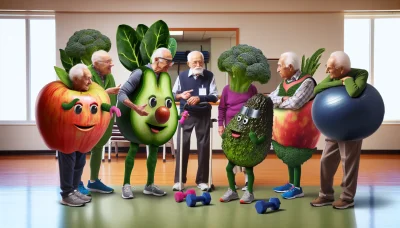Retired dieter Quiz
Test Your Knowledge
Question of
Understanding Retirement Dieting
Adjusting Nutritional Needs Post-Retirement
Assessing Caloric Requirements
As we age, our metabolic rate often slows down, which means calorie needs decrease. It's crucial to recognize this shift to prevent unwanted weight gain. Retirees should focus on consuming nutrient-dense foods that provide energy without excessive calories.
Regular physical activity is also a key component in managing caloric requirements. Even light exercises such as walking or swimming can help maintain a healthy metabolism. Consulting with a healthcare professional can help determine an ideal caloric intake for your lifestyle.
Managing Macronutrient Intake
Balancing macronutrientsproteins, fats, and carbohydratesis essential for maintaining muscle mass and overall health. A diet rich in lean proteins and healthy fats, with moderate complex carbohydrates, can support retirees' health goals.
Incorporating a variety of protein sources, such as fish, legumes, and poultry, ensures adequate intake while also providing essential nutrients. Mindful consumption of fats, focusing on unsaturated sources like olive oil and avocados, supports heart health.
Addressing Micronutrient Deficiencies
Micronutrients play critical roles in maintaining health. Common deficiencies in older adults include vitamin D, calcium, and B vitamins. Ensuring a varied diet rich in fruits, vegetables, whole grains, and lean proteins can mitigate these risks.
Supplementation might be necessary for some retirees to meet their micronutrient needs. It's important to consult with a healthcare provider before starting any supplement regimen to avoid potential interactions with medications or other health conditions.
Overcoming Common Dietary Challenges for Retirees
Coping with Reduced Appetite
A diminished appetite is common among retirees but ingesting enough nutrients is still imperative. Eating smaller, more frequent meals can help maintain nutrient intake without overwhelming the appetite.
- Eat nutrient-rich foods like nuts and seeds that are high in calories and nutrients but low in volume.
- Focus on hydrating foods such as soups and smoothies that are easier to consume and digest.
- Enhance flavors with herbs and spices to stimulate appetite and make meals more appealing.
Dealing with Digestive Changes
Gastrointestinal changes can affect nutrient absorption in retirees. High-fiber diets aid digestion and promote regularity. Hydration also plays a vital role in digestive health; thus, sufficient fluid intake is non-negotiable.
Adapting to Lifestyle Shifts
The transition into retirement brings lifestyle changes that can impact eating habits. Structuring meals around social activities or hobbies can provide both nutritional benefits and enhance overall enjoyment of life post-retirement.
Healthy Eating Plans for Retirees
Mediterranean Diet for Sustained Health
The Mediterranean diet is a fantastic choice for retirees looking to maintain robust health. It's packed with fresh fruits and vegetables, whole grains, and healthy fats, predominantly from olive oil. Studies have shown that this diet reduces the risk of heart disease and other age-related conditions.
Embracing the Mediterranean lifestyle means more than just changing your food; it includes a holistic approach to meal times, emphasizing enjoyment and socializing over meals. This diet isn't just about what you eat but how you eat, fostering an overall better quality of life.
Heart-Healthy Fats and Oils
The key to the Mediterranean diet's success is its focus on heart-healthy fats. Olive oil reigns supreme here, offering a wealth of benefits for your cardiovascular system. It's not just about adding olive oil to your dishes; it's about replacing unhealthy fats with this liquid gold that can help keep your heart in top shape.
Avoiding trans fats and limiting saturated fats are cornerstones of this diet. By sticking to fats from nuts, seeds, avocados, and fish, retirees can significantly improve their heart health. Remember, moderation is key even with healthy fats!
Whole Grains and Fiber-Rich Foods
Whole grains are integral to the Mediterranean diet, providing essential nutrients and fiber that aid digestion and control blood sugar levels. Replace refined grains with whole options like brown rice, quinoa, and whole wheat pasta to reap these benefits.
Fiber-rich foods not only promote good digestive health but also help you feel full longer. Eating a variety of fruits, vegetables, and legumes daily can dramatically increase your fiber intake without much effort.
Fish and Poultry as Protein Sources
Fish and poultry are excellent protein sources for retirees following the Mediterranean diet. These lean proteins contribute to muscle maintenance without the added saturated fat found in red meats.
- Incorporate fish such as salmon or mackerel at least twice a week for omega-3 fatty acids.
- Poultry provides a versatile protein source that can be grilled, baked or sauted.
- Limit red meat consumption to a few times per month to maximize the health benefits of this dietary pattern.
- Consider plant-based protein sources like lentils or chickpeas as meat alternatives.
Anti-Inflammatory Diets to Combat Aging
An anti-inflammatory diet is another excellent option for retirees aiming to counteract the effects of aging. Chronic inflammation can lead to numerous age-related diseases; thus, eating foods that combat inflammation is crucial for longevity.
This diet focuses on consuming fruits, vegetables, nuts, whole grains, fish, and healthy oils while reducing intake of processed foods and red meats. The result is a nutrient-rich plan that supports overall health and helps manage inflammation levels in the body.
Foods Rich in Antioxidants
Antioxidants are warriors against oxidative stress which contributes to inflammation. By eating foods high in antioxidants like berries, leafy greens, nuts, and seeds retirees can protect their cells from damage.
- Berries such as blueberries and strawberries are delicious sources of antioxidants.
- Nuts like almonds and walnuts not only provide healthy fats but are also rich in antioxidants.
- Dark chocolate in moderation offers antioxidants along with a satisfying treat!
- Spices like turmeric contain curcumin which has potent anti-inflammatory properties.
Reducing Processed Food Intake
Avoiding processed foods is critical when following an anti-inflammatory diet. These foods often contain unhealthy additives and high levels of sodium which can contribute to inflammation in the body.
- **
- Read Labels: Always check labels for added sugars, artificial ingredients or preservatives which signal processed foods. ** **
- Cook at Home: Preparing meals at home puts you in control of ingredients ensuring they're fresh and unprocessed. ** **
- Avoid Packaged Snacks: Choose whole food snacks like fruits or nuts over packaged chips or cookies. ** **
- Limited Fast Foods: Fast food is convenient but often heavily processed; opt for healthier alternatives when dining out. ** **
- Select Whole Foods: Base shopping around the perimeter of grocery stores where fresh produce is typically located. ** **
- **
Incorporating Omega-3 Fatty Acids
** **Omega-3 fatty acids are essential in fighting inflammation throughout the body. Regular consumption through fish or plant-based sources like flaxseeds can have significant anti-inflammatory effects.
** **- ** userService
Weight Management After Retirement
Strategies for Losing Weight Safely
After retirement, the shift in daily routine can impact your weight. It's crucial to approach weight loss with strategies that prioritize safety and health. Begin by consulting a healthcare provider to tailor a plan that's right for you, considering any existing health conditions.
Combining dietary changes with increased physical activity is the golden rule for shedding pounds. Remember, losing weight isn't an overnight phenomenonit requires consistency and determination. Let's dive into some safe and effective methods to achieve your weight loss goals.
Setting Realistic Weight Loss Goals
Realistic goals are the backbone of successful weight management. Aiming to lose one to two pounds per week is sensible and sustainable. Break down your overall target into smaller milestones to keep motivation high and celebrate your progress along the way.
- Evaluate current eating habits and identify areas for improvement.
- Set achievable short-term goals to build momentum.
- Maintain a balanced approach, avoiding extreme diets or excessive exercise.
- Track your progress with tools like food diaries or apps.
Importance of Strength Training
Muscle mass naturally decreases with age, but strength training can counteract this trend. It boosts metabolism, helping you burn more calories even at rest. Incorporate resistance exercises into your routine two to three times per week for optimal benefits.
- Start with light weights or body-weight exercises to build foundational strength.
- Increase the intensity gradually to challenge your muscles without risking injury.
- Consider working with a fitness professional to ensure proper form and technique.
- Vary your workouts to target different muscle groups and prevent boredom.
Balancing Diet and Exercise
A harmonious balance between diet and exercise is key for losing weight safely after retirement. Opt for a diet rich in whole foods, like fruits, vegetables, lean proteins, and whole grains. Pair this with regular physical activity tailored to your interestswhether it's walking, swimming, or yogato create a calorie deficit without deprivation.
Maintaining a Healthy Weight Long-Term
Maintaining a healthy weight after achieving your weight loss goals demands a lifelong commitment to healthy habits. It's not just about the number on the scale; it's about nurturing your overall well-being through mindful choices each day.
Mindful Eating Practices
Mindful eating encourages awareness of hunger cues and emotions related to food. It involves savoring each bite and choosing foods that satisfy both taste and nutritional needs. By eating mindfully, you're more likely to maintain portion control and make informed food choices that support weight maintenance.
Regular Physical Activity Routines
A consistent exercise routine is vital for keeping those extra pounds at bay. Aim for at least 150 minutes of moderate aerobic activity weekly, as recommended by health experts. This could include activities like brisk walking, cycling, or even gardeninganything that gets the heart rate up counts!
Periodic Health Check-ups and Monitoring
Last but not least, regular check-ups with your healthcare provider play a significant role in long-term weight management. These visits are opportunities to assess your health status, adjust strategies if needed, and catch potential issues early on. Self-monitoring techniques such as weighing yourself weekly can also help maintain accountability.
Special Diets for Age-Related Health Conditions
Diabetic-Friendly Meal Planning
Embarking on a diabetic-friendly meal plan is not just a dietary choiceit's a fundamental part of managing your health and vitality! With the right foods, you can maintain stable blood sugar levels and enjoy delicious meals. Begin by embracing whole, unprocessed foods that release energy slowly.
It's essential to understand the role of carbohydrates in your diet. They are not your enemy, but knowing which types and how much to consume can make all the difference. Balance is keypairing carbs with proteins and healthy fats can prevent blood sugar spikes.
Fiber is your secret weapon in the fight against diabetes. It slows down glucose absorption and improves your overall digestive health. Incorporating a variety of fiber-rich foods into each meal will keep you feeling full and energized throughout the day.
Low-Glycemic Index Foods
Low-glycemic index (GI) foods are superheroes for those managing diabetes! They have a minimal impact on blood glucose levels, making them an ideal choice for maintaining steady energy. Focus on legumes, whole grains, and most fruits and vegetables.
Adopting a low-GI diet isn't just about picking the right foods; it's about revolutionizing your approach to eating. Say goodbye to refined sugars and hello to nutrient-dense meals that pack a punch without spiking your sugar!
Monitoring Carbohydrate Consumption
- *Enumerative Lists: Ordered Lists: 1. Track your daily carb intake with a food diary or app. 2. Understand carb servings and read nutrition labels diligently. 3. Plan meals ahead to ensure balanced carb distribution throughout the day. Unordered Lists: - Include complex carbs like brown rice and quinoa over simple sugars. - Be mindful of hidden carbs in sauces, dressings, and beverages. - Adjust carbohydrate intake based on activity level and blood sugar readings.
Importance of Fiber in Blood Sugar Control
- 1. Fiber-rich foods like beans, oats, and flaxseeds help regulate blood sugar levels. 2. Soluble fiber specifically assists in slowing down carbohydrate digestion. 3. Aim for at least 25 grams of fiber daily for optimal blood sugar control. 4. Incorporate vegetables into every meal for an added fiber boost.
Heart Health and Cholesterol Management
Maintaining heart health is non-negotiable as we age! A diet low in sodium and saturated fats is crucial for keeping cholesterol levels in check and reducing the risk of heart disease. Embrace lean proteins, plenty of fruits and vegetables, and whole grains.
Regular cardiovascular exercise works hand-in-hand with diet to manage cholesterol effectively. Whether it's brisk walking, swimming, or cycling, find an activity you love to keep your heart pumping strong!
Reducing Sodium and Bad Fats
- *Descriptive Lists: - Opt for fresh herbs and spices instead of salt to flavor dishes. - Choose lean cuts of meat or plant-based protein sources like lentils or tofu. - Read labels carefully to avoid trans fats found in many processed foods. - Swap out high-fat dairy products for their low-fat or non-fat counterparts. - Cook with healthy oils such as olive oil instead of butter or lard. - Steer clear of fast food which often contains both excessive sodium and unhealthy fats.
Increasing Soluble Fiber Intake
Soluble fiber is particularly effective at lowering bad cholesterol (LDL). It acts like a sponge, absorbing cholesterol so that it can be eliminated from the body rather than clogging arteries.
- 1. Start your day with a bowl of oatmeal topped with berries for a soluble fiber kickstart. 2. Add barley, lentils, or beans to soups and stews for an easy soluble fiber boost. 3. Snack on nuts like almonds or walnuts which contain both soluble fiber and healthy fats. 4. Make sure you're getting enough psyllium huska powerful source of soluble fiber found in many supplements.
Importance of Regular Cardiovascular Exercise
- *Priority Lists: - High Priority: Engage in at least 150 minutes of moderate-intensity aerobic exercise per week. - Medium Priority: Incorporate strength training exercises twice per week alongside cardio workouts. - Low Priority: Include flexibility exercises such as yoga or stretching routines into your weekly regimen. *Checklists: - [ ] Schedule consistent workout times each week to establish a routine. - [ ] Choose activities that you enjoy to maintain motivation over time. - [ ] Monitor heart rate during exercise to ensure you're working within your target zone. *Comparative Lists: Advantages of Regular Exercise - Improves cardiovascular endurance - Helps lower blood pressure - Enhances mood through endorphin release Disadvantages of Sedentary Lifestyle - Increases risk of heart disease - Contributes to weight gain - Can lead to decreased energy levels
Enhancing Cognitive Function Through Diet
Brain-Boosting Foods for Retirees
Retirement is a time of transformation, and maintaining cognitive health is crucial. Incorporating certain foods into your diet can work wonders for your brain's vitality. These superfoods are not just beneficial; they're a delicious way to boost neural function!
Omega-3s and Cognitive Decline Prevention : Omega-3 fatty acids are absolute game-changers when it comes to brain health. Found in abundance in fish like salmon and sardines, they help maintain brain structure and function, reducing the risk of cognitive decline.
Antioxidant-Rich Berries and Brain Health : Berries aren't just tasty; they're packed with antioxidants that fight oxidative stress, which can damage brain cells. Blueberries, strawberries, and blackberries are all excellent choices for keeping your mind sharp as a tack!
Role of Leafy Greens in Mental Acuity : Leafy greens like spinach, kale, and collards are loaded with vitamins and nutrients such as vitamin K, lutein, folate, and beta carotene. These nutrients support brain health and may slow cognitive declineso pile those greens high on your plate!
Avoiding Nutritional Pitfalls That Affect Memory
Nutrition has a profound impact on memory and cognitive function. Avoiding certain dietary pitfalls can be just as important as consuming the right foods. Be vigilant about what you eat; your brain will thank you!
Limiting Sugar and Refined Carbs : Excessive sugar and refined carbs can wreak havoc on your cognitive abilities. They can impair memory and reduce brain volume, particularly in the area of the brain that stores short-term memory.
- Avoid sugary drinks like soda and fruit juice concentrates.
- Cut down on sweets such as cookies, cakes, and candy bars.
- Choose whole grains over white bread, pasta, and rice.
- Read labels carefully to identify hidden sugars.
Staying Hydrated for Optimal Brain Function : Water is essential for lifeand that includes brain life! Dehydration can lead to confusion, irritability, and cognitive impairment. Make sure you're drinking plenty of fluids throughout the day to stay sharp.
- Aim for at least 8 glasses of water per day.
- Incorporate water-rich foods like cucumber, celery, and watermelon into meals.
- Moderate your intake of caffeinated beverages as they can lead to dehydration.
- Keep a reusable water bottle handy as a reminder to drink regularly.
The Impact of Alcohol on Cognitive Health : While moderate alcohol consumption may have some health benefits, excessive drinking is detrimental to cognitive function. Over time it can lead to memory loss and diminished executive functionmoderation is key!
Social Aspects of Eating in Retirement
Cooking and Dining as Social Activities
Cooking isn't just about nourishment; it's a fantastic avenue for socialization! Imagine the joy of whipping up a delicious meal while laughing and learning alongside peers. Retirement offers ample time to explore culinary skills with friends, turning each meal into an event to look forward to.
Community cooking classes are a treasure trove of opportunity! They offer the chance to mingle, share family recipes, and bond over the universal language of food. Plus, they're a great place to pick up new cooking techniques and health tips tailored for retirees.
- Explore different cuisines to keep your palate excited.
- Look for classes that focus on nutritious meals that are simple yet delicious.
- Dont forget to share your knowledge with others teaching is also a fulfilling experience!
Potlucks embody the essence of community dining. They're not just about sharing a meal; they're about sharing stories, laughter, and creating bonds. Each dish tells a story of heritage or personal preference, making each gathering a unique experience.
Dining clubs for retirees are booming! They offer regular meetups at local eateries or members' homes, providing an excellent opportunity for social interaction. It's like having an ever-evolving dinner party where friendships flourish over fine food!
Navigating Eating Out and Traveling
Eating out can be both enjoyable and healthy with the right approach. Many restaurants now cater to health-conscious diners with special menus. Taking advantage of these options means you can dine out without derailing your dietary goals!
- Choose restaurants that offer 'heart-healthy' or 'lighter fare' menus.
- Don't be afraid to ask for modifications to dishes to fit your dietary needs.
- Consider portion sizes sharing or taking home leftovers can help manage calorie intake.
- Avoid buffets which may lead to overeating; opt for la carte options instead.
Packing nutritious snacks is essential when traveling. It prevents the temptation of unhealthy airport or roadside food, ensuring you have access to wholesome choices no matter where you are!
- Pack fruits, nuts, and whole-grain snacks that are portable and non-perishable.
- Stay hydrated with water rather than sugary drinks or excessive caffeine.
- Research restaurants at your destination that offer healthy options in advance.
Traveling introduces you to diverse cuisines which can be both exciting and intimidating. Embrace local foods by choosing dishes rich in vegetables, lean proteins, and whole grains. This way, you can savor new flavors while maintaining a balanced diet.












